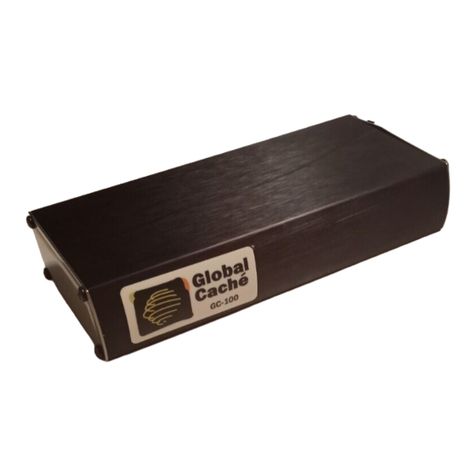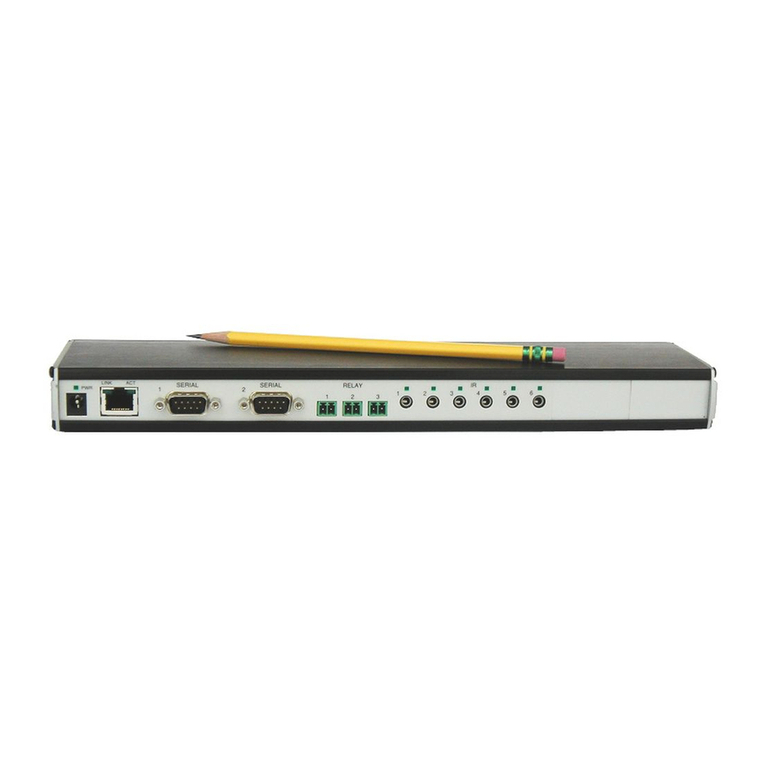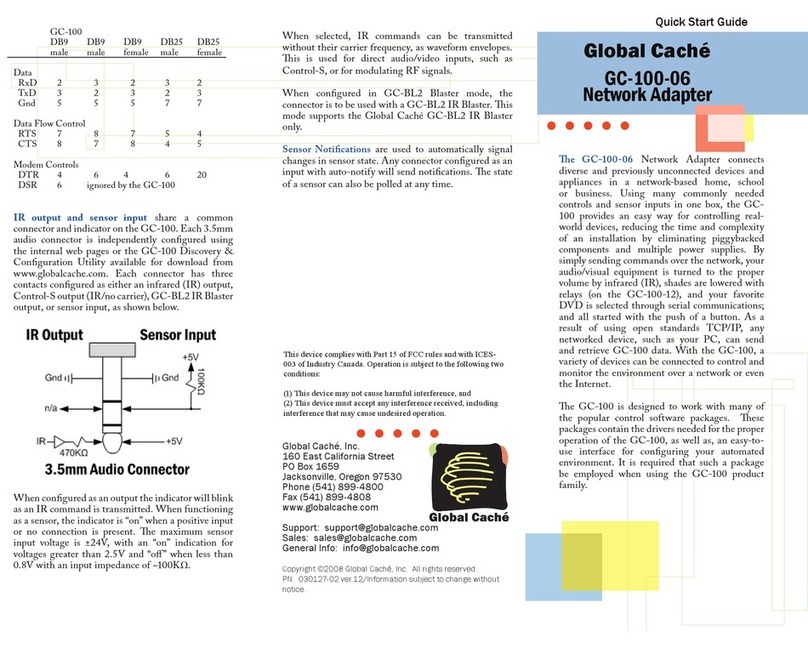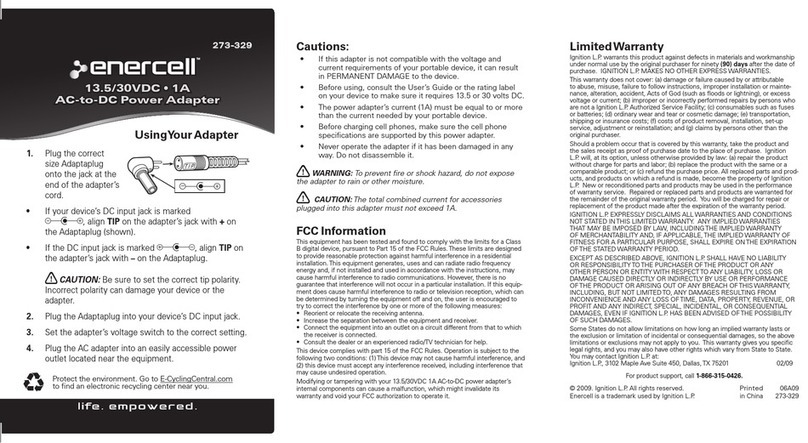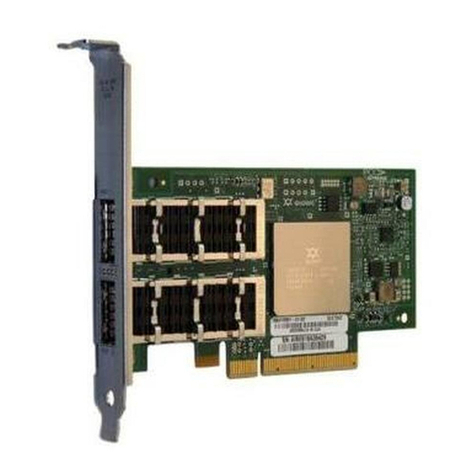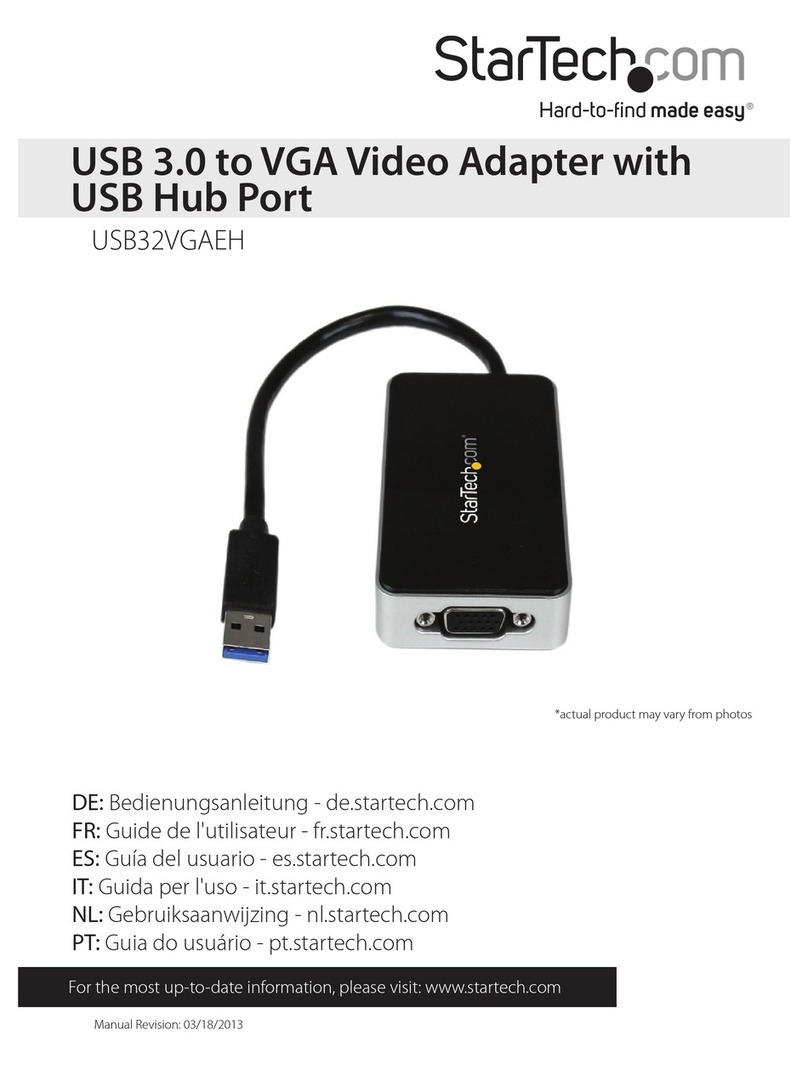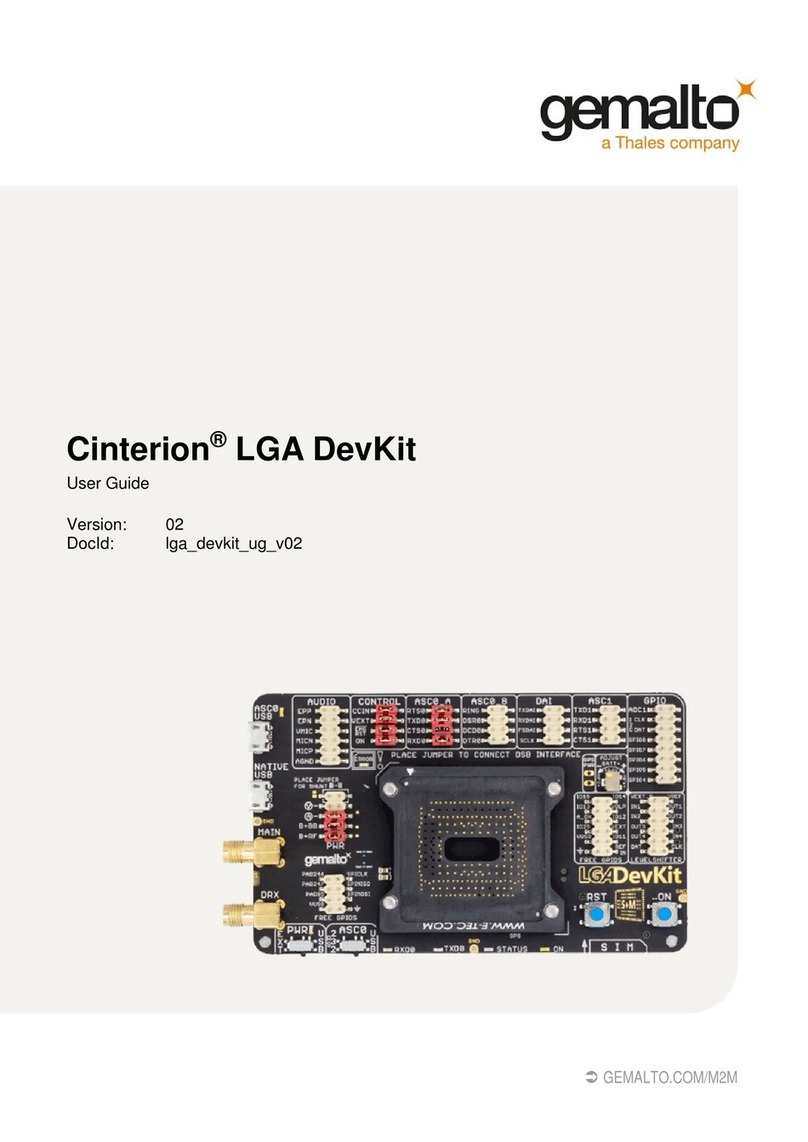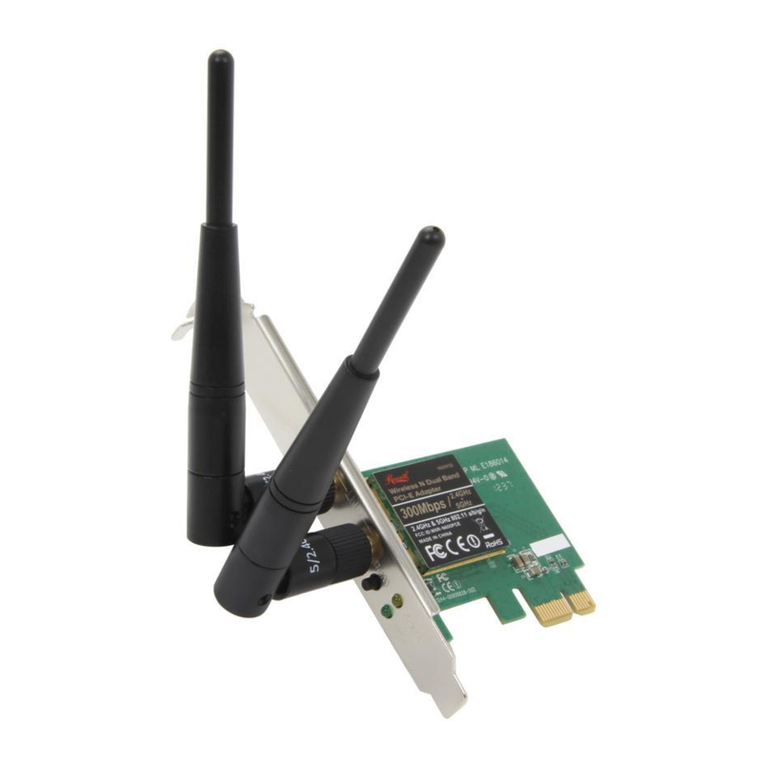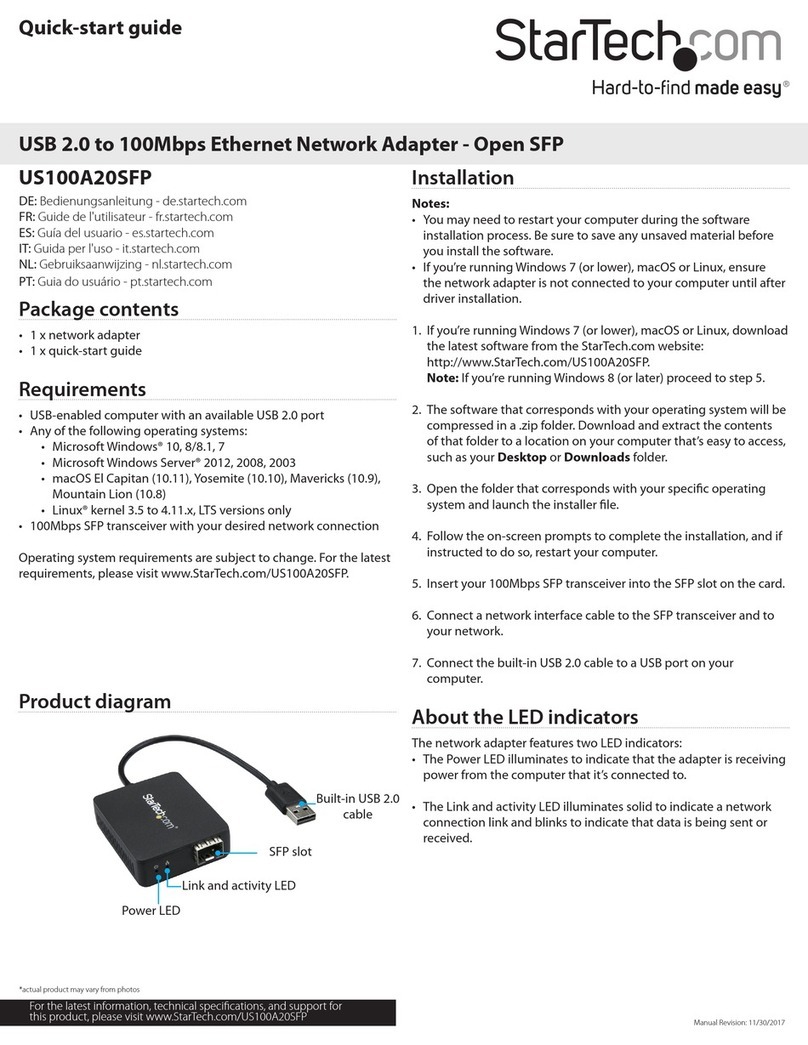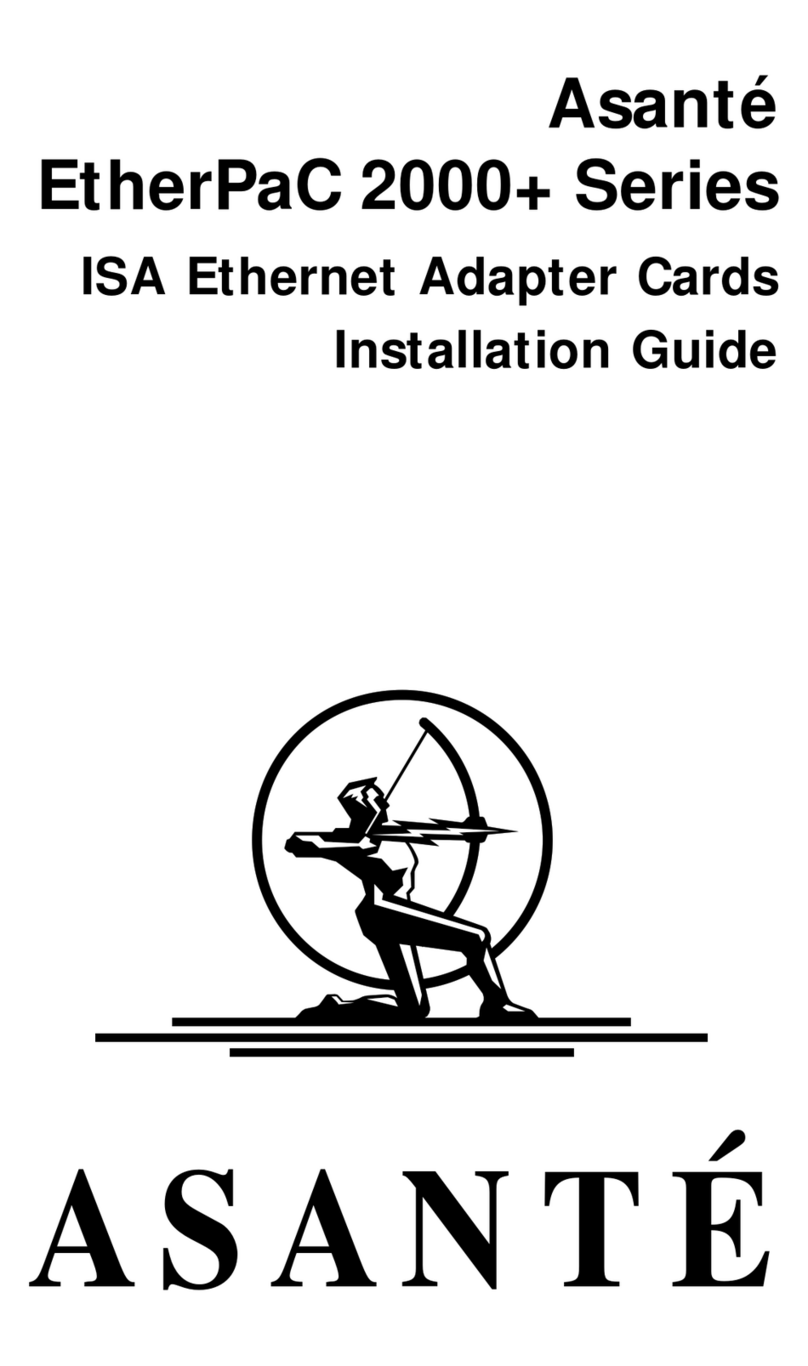Global Cache GC-100-06 User manual

Quick Start Guide
Global Caché
GC-100-06
Network Adapter
The GC-100-06 Network Adapter connects diverse and previously unconnected devices and appliances in a network-based
home, school or business. Using many commonly needed controls and sensor inputs in one box, the GC-100 provides an easy
way for controllin g real-world devices, reducing the time and co mplexity of an installation by eli minating piggyb acked
components and multiple power supplies. By simply sending commands over the network, your audio/visual equipment is
turned to the proper volume by infrared (IR), shades are lowered with relays (on th e GC-1 00-12), and your favorite DVD is
selected through serial communications; and all started with th e push of a button. As a result of using open standards (for
example, TCP/IP), any networked device, such as your PC, can send and retrieve G C-100 data. W ith the GC-100 , a variety of
devices can be connected to control and monitor the environment over a network or even the Internet.
The GC-100 is designed to w ork with many of the popu lar control softwar e p ackages. These packages contain the d rivers
needed for the proper operation of the GC-100, as well as, an easy-to-use interface for configuring your automated
environment. It is required that such a package be employed when using the GC-100 product family.
Getting started is simple. All it req uires is connecting power, configuring the unit, and attaching cables. This guide provides a
step-by-step method to get you up and running quickly and easily with a discussion of each connector's pin out, web page
configuration, and specification.
Power is supplied by an AC wall adapter rated for 9V to 18V DC@300mA. Shor tly after applying power all the I R indicator s
will momentarily turn on th en off signifying completion of the self-test. The GC-100 is ready for operation after the power
(PWR) indicator is on and not blinking which signifies a self-test fault.
LAN connectio n is u sed for all communica tion over the networ k and for configuring the GC-100. Accessing the GC-100 is
initially achieved using its default IP addr ess 192.168.1.7 0. The best method for configu ring the GC-100 is to communicate
over an iso lated network, d irectly to a n etworked PC utilizin g a cross-ov er LAN cable or an isolated hub with standard LAN
cables. Th e PC must also be on the same n etwork w ith an address such as 192.168 .1.102. The "LINK" indicator on the LA N
connector will ligh t when the cabling is p lugged in properly. After estab lishing a link, the GC-100's internal web pages are
accessible from a browser at address:
http://192.16 8.1.70/
A suitable static IP address can now be entered for your network environment, making sure the GC-100's IP address is outside
the network 's DHCP partition, if DHCP is used. In additio n the default gateway address and subnet mask will need to b e set
before installing the GC-100. Once the GC-100 is on your network, further configuration can be accomplished through the new
IP address.
Except for serial, all data commands are sent over TCP/IP
Port 4998. This includes infrared, sensor, and relay
commands. Each serial connection has a unique port
number for communication, starting with Port 4999 for
serial 1, Port 5000 for the next serial connector, and so on.
Factory defaults can be set du ring power up by connecting
pins 7 and 2 on connector SERIAL 1 with a wrap back
connector or a flat bladed screw driver. (Refer to the Serial DB9 Connector diagram for pin locations .) IR in dicator 1 will blink
on then o ff, signifying the GC-100 has b een set to factor y defaults, including Con figuration Lock, which d efaults to disabled.
Power
LAN
Serial
IR and Sensor
GC-100-06 Front Panel
Web pages are used to configure the GC-100 for proper operation in a particular environment. Parameters are selected by pull
down menu s and put in effect after executing "Apply." The GC-100 resets, blinking all indicators on then off, to complete the
update.
GC-100-06 Quick Start Guide - PDF 11894 Upper Applegate Road
Effective: January 18, 2007 Jacksonville, Oregon 97530
PN: 030127-02 pdf ver. 10 Phone: 541-899-4800
1 of 3 Fax: 541-899-4808
www.globalcache.com

Serial communication utilizes a male (9 pin ) DB9 conn ector with active signals on the pins shown in the diagram.
Unfortunately, serial standards are not always adhered to, and special attention must be given when connecting serial cables.
There are three areas that must be correct for proper serial communication: cable configuration; baud rate (communication
speed); and, if used, flow control signals must be asserted (greater than +3V). At a minimum, to send and receive serial data
TxD, RxD, and Gnd must be connected to the o ther serial d evice. These sig nal lo cations will depend on the mating connector’s
type and gender. Typically, communications can be established by a trial and error method of swapping the TxD and RxD
lines. (Incorrect wiring will no t harm RS232 drivers.) Also, flow control must be d isabled or asserted for co mmunications to
start. If erroneous ch aracters are transmitted, it is u sually an ind ication of an incorrect b aud rate setting.
Serial DB9 Male Connector
TxD
RTS
RxD
CTS
Pin 4
Pin 8
Pin 3
Pin 7
Pin 2
DT
R
+12V
Pin 5
GC-100
There are two types of flow control: RTS/CTS for data flow and DTR/DSR for modem control. The GC-100 does not use
modem flo w control and will always assert the DTR lin e an d ign ore DSR. When data flow con trol is u sed, the GC-1 00 will
stop its transmission when its CTS signal is asserted by the other device. When receiving data the GC-100 may assert RTS to
signal the other device to stop its transmission. In a typical control environment, serial devices usually communicate with short
and infrequent commands. Hence, some serial devices may not have flow control signals. This is usually not a concern, since a
serial input buffer is much larger (256 bytes) than the transmitted data command s. In th ese cases, the GC-100 flow control
should be disabled. Howev er, to avoid potential character loss, it is a good rule to use flow control when it is av ailable on serial
devices. The GC-100 perf orms flow control b y asserting RTS when the inpu t buffer goes beyond 192 b ytes, and de-asserting
RTS when it falls below 64 bytes. In either case, th e GC-100 records all serial buffer overflows and maintains a count on the
Network web page.
The serial device attaching to the GC-100 will most likely employ a DB9 or 25 pin conn ector. Below is the standard wiring
configuration for a serial cable. It is no t guaranteed that th e standard has been fo llowed, but it is a good starting place.
C-100 DB9 DB9 DB25 DB25
DB9 male male female male female
Data
RxD 2 3 2 3 2
TxD 3 2 3 2 3
Gnd 5 5 5 7 7
Data Flow Control
RTS 7 8 7 5 4
CTS 8 7 8 4 5
Modem Controls
DTR 4 6 4 6 20
DSR 6 ignored by the GC-100
GC-100-06 Quick Start Guide - PDF 11894 Upper Applegate Road
Effective: January 18, 2007 Jacksonville, Oregon 97530
PN: 030127-02 pdf ver. 10 Phone: 541-899-4800
2 of 3 Fax: 541-899-4808
www.globalcache.com

IR output and sensor input share a common connector and indicator on th e GC-100. Each 3.5mm au dio conn ector is
independently configured using the internal web pages. Each connector has three contacts configured as either an infrared (IR)
output, Control-S output (IR/no carrier), or sensor input, as shown below.
Sensor Input
IR Output
+5V
100K
Ω
10
K
Ω
Gn
d
Gn
d
n/a
Senso
r
IR
470Ω
+5V
3.5mm Audio Connector
When configured as an ou tput the ind icator will blin k as an IR command is transmitte d. When fu nctioning as a sensor, the
indicator is "on" when a positive input or no connection is present. The maximum sensor input voltage is ±24V, with an "on"
indication for voltages greater than 2.5V and "off" when less than 0.8V with an input impedance of ~100KΩ.
When selected, IR outpu ts can be transmitted without their carrier frequency, as waveform envelop es. This is u sed for direct
audio/video inputs, such as Control-S, or for modulating RF signals.
Sensor Notifications are use d to automatically signal changes in se nsor state. Any connector configured as an input will
send notification unless this feature is disabled.
Global Caché, Inc.
11894 Upper Applegate Road
Jacksonville, Oregon 97530
Phone (541) 899-4800
Fax (541) 899-4808
www.globalcache.com
Copyright ©2007 Global Caché, Inc. All rights reserved.
PN: 030127-02pdf ver. 10/Information subject to change without notice.
GC-100-06 Quick Start Guide - PDF 11894 Upper Applegate Road
Effective: January 18, 2007 Jacksonville, Oregon 97530
PN: 030127-02 pdf ver. 10 Phone: 541-899-4800
3 of 3 Fax: 541-899-4808
www.globalcache.com
Table of contents
Other Global Cache Adapter manuals
